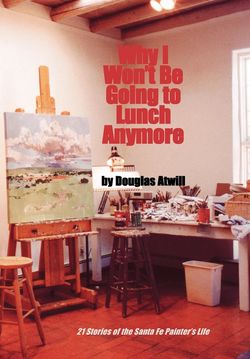Читать книгу Why I Won't Be Going To Lunch Anymore - Douglas Atwill - Страница 12
На сайте Литреса книга снята с продажи.
Fifty by Fifty
ОглавлениеMariana Benavides worked mornings for the painter Alabaster Prynne, doing the studio tasks that Prynne, at her great age, did not want to deal with anymore. She stretched canvases, cleaned the brushes and the knives, and she was learning the secrets of framing a canvas in Prynne’s distinctive style. Prynne knew she had found a young jewel in Mariana, an agreeable sponge eager to absorb any of the studio knowledge that the older woman chose to divulge.
The morning was coming to a close when Prynne broke the silence that was customary in their working hours. “Mariana, my dear, how are you doing in your own work? What are you painting now?”
“I’m working on a large canvas. A scene of Santa Fe with the cathedral.”
“Large? How large?” Prynne asked.
“Thirty six inches by twenty four inches. I bought a linen canvas at the art supply, already stretched.”
“But that’s not very large by modern standards, thirty six by twenty four.”
“Papa says it is too large. He thinks that a retablo is just about the right size for a painting, any painting,” Mariana said.
“Well, your papa is not wrong. He is, however, accustomed to working in the manner of the eighteenth century. Things were smaller then. Big pieces of anything were in short supply. Artists were lucky to find even a small piece of flat wood.”
The two women continued work on the last of the canvases Prynne had ready for Mariana to stretch. Prynne held the frame square while Mariana pulled the linen fabric with the canvas pliers.
“So why is it better to paint large?” asked Mariana.
“It releases you as nothing else. A small painting can never be more than a painting; a large one can hope to be a universe or a new idea.”
“How large?”
“At least fifty inches by fifty inches,” said Prynne, describing with her long hands a canvas of that size.
“I will try one this week, Miss Prynne.”
“Good. You’re strong and can easily work on a panel of that size. There is the added value, Mariana, of your producing a piece that shocks, not expected from a young woman. A large size alone might be able to do that.”
“That would please me.”
“Take some of my stretchers and some of the primed canvas. You can pay me back when the painting sells. You’ll love it so much, Mariana, you will never want to go back to the smaller sizes.”
“Let me tell you what I have in mind.”
“Absolutely not. Keep it a close secret until you show me the finished work.”
Mariana left the Prynne Studio with her new supplies and walked a block up Canyon Road to her father’s gallery, El Santero, subtitled Santa Fe’s Best Family Art. For many years the Benavides sold the santos and retablos carved and painted by their family artisans. Both her father’s family, the Benavides, and her mother’s, the Sanchez y Pinos, produced famous santeros for many generations.
Talent from both the Benavides line and the Sanchez line combined in Mariana; the judges at the annual Spanish Market picked the expert crafting of her santos for special mention when she was just fourteen. To have such ability in one so young was clearly miraculous, a gift from on high.
She worked for her father, a widower, at El Santero on most afternoons, selling the highly colored religious pieces that collectors expected from the Benavides clan. In the past years there had been a change in how pieces were produced for El Santero. Mariana’s prodigious output had eclipsed that of her older brother, Juanito, and even of her father. Her artistic vigor was a major family asset, especially since their mother could no longer add to the family enterprise.
